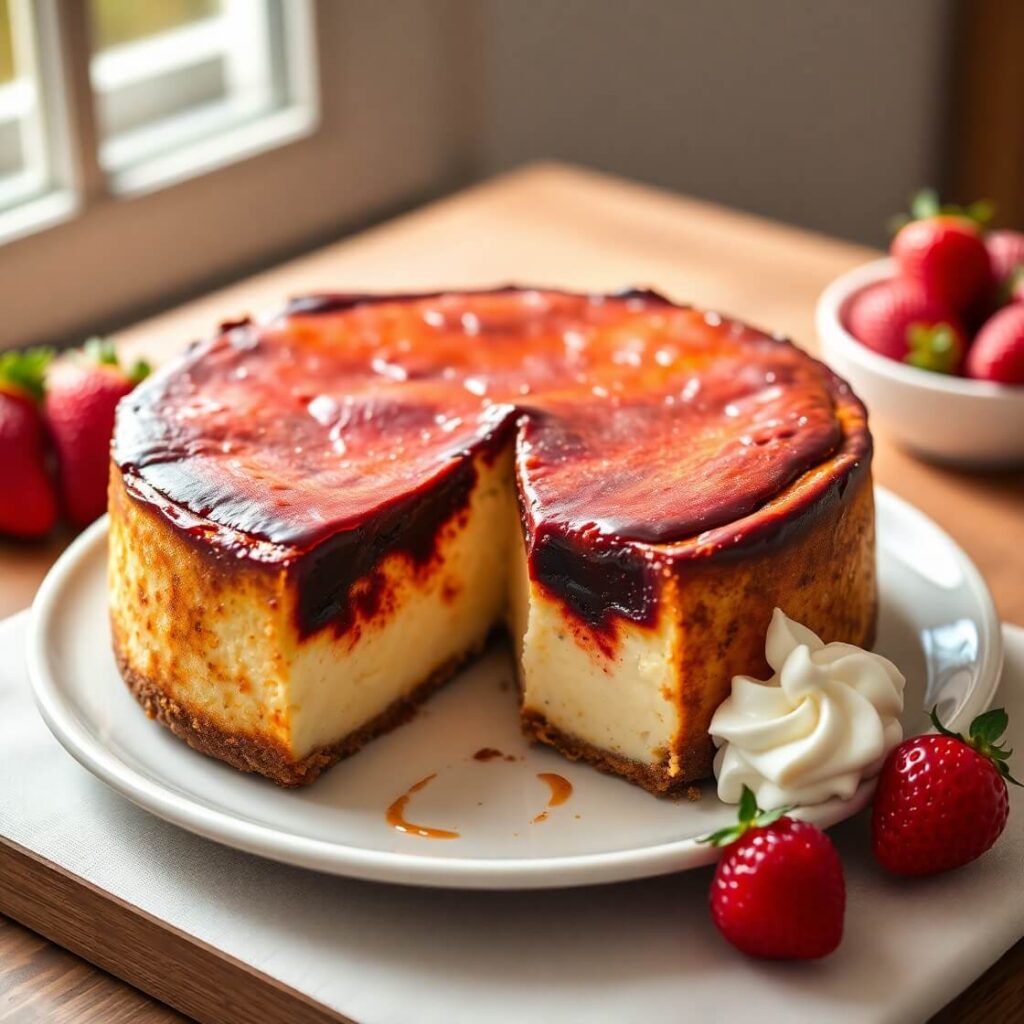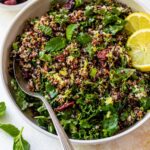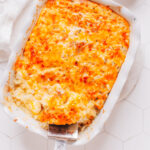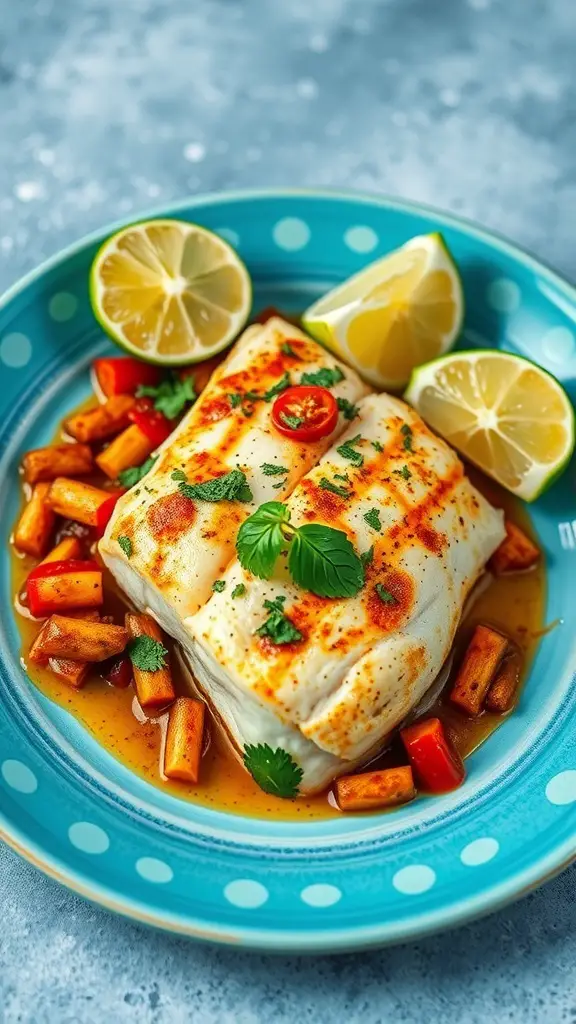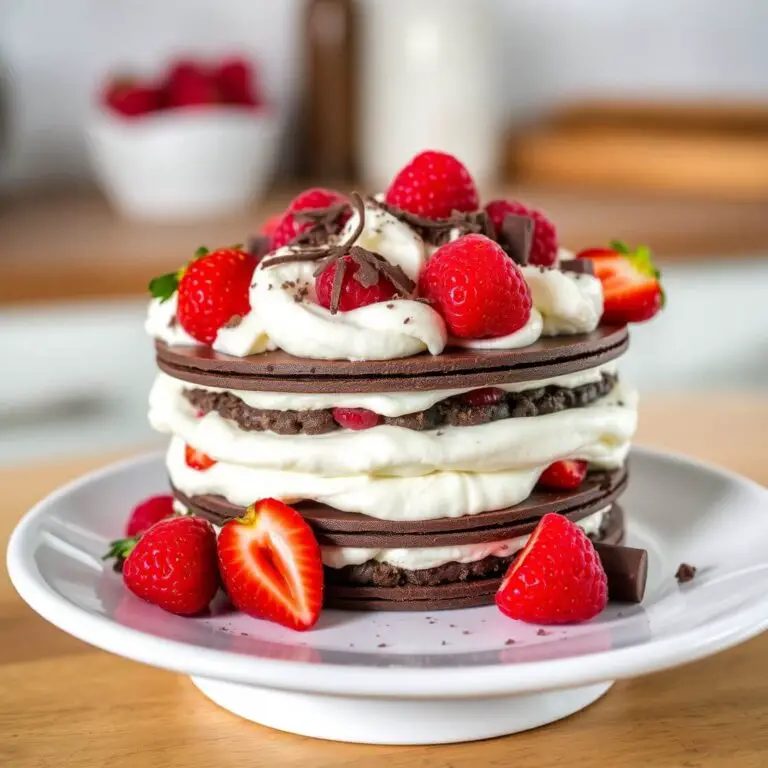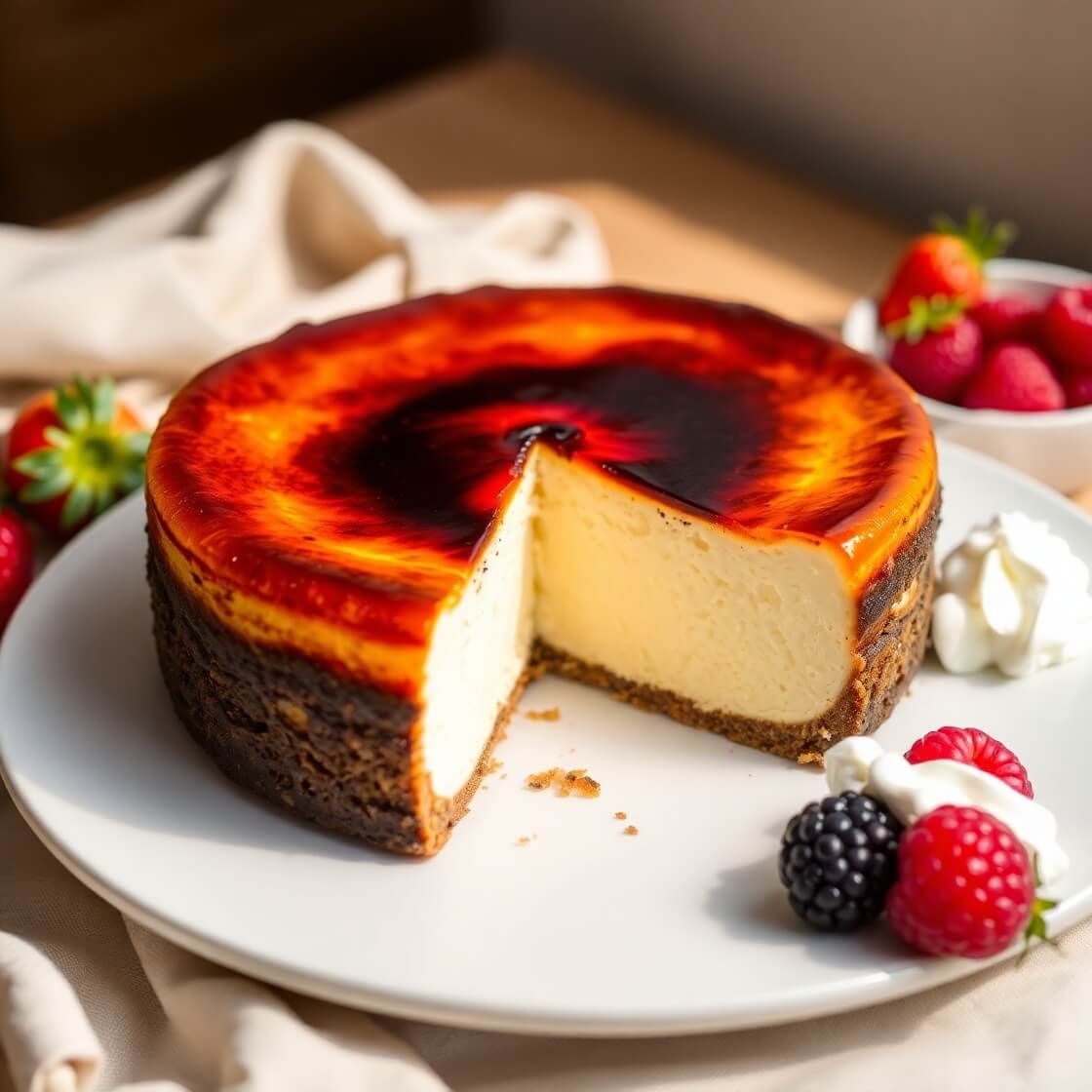
Basque Burnt Cheesecake is a unique and indulgent dessert that has taken the culinary world by storm. Originating from the Basque region in Spain, this cheesecake stands apart from traditional cheesecakes with its deeply caramelized top and creamy, custardy center. I discovered this recipe after a trip to Spain, where the rustic, slightly burnt exterior combined with the rich interior left a lasting impression on me. It’s a dessert that’s simple yet elegant, perfect for anyone who loves cheesecake but is looking for a twist that’s less sweet and more complex in flavor.
If you’re curious about trying a cheesecake that breaks the mold—one with a beautifully blistered top and a luscious creamy inside—keep reading. This recipe guide will walk you through every detail, making sure your Basque Burnt Cheesecake turns out perfect every time.
Why I Love This Recipe
One of the reasons Basque Burnt Cheesecake stands out is because it embraces imperfection. Unlike traditional cheesecakes that aim for a smooth, flawless surface, this one thrives on its charred, rustic look. The burnt top adds a subtle smoky bitterness that perfectly balances the creamy sweetness inside, creating a depth of flavor that’s both surprising and comforting.
People make this cheesecake because it’s incredibly simple to prepare but yields a result that looks and tastes sophisticated. You don’t need a crust or complicated techniques—just quality ingredients and a hot oven to achieve that signature burnt surface. This recipe is especially beloved for its texture contrast: the outside is slightly firm and caramelized, while the inside remains silky and creamy, almost like a custard.
If you want a dessert that’s a little different, less fussy, and full of character, this is it. Plus, it’s a crowd-pleaser that impresses without hours of effort.
Ingredients for Basque Burnt Cheesecake
To make this cheesecake, you only need a handful of ingredients, but the quality of each makes all the difference. Here’s what you’ll need:
- Cream cheese: Full-fat cream cheese is a must for that rich, creamy texture.
- Granulated sugar: Adds sweetness, but not overpowering.
- Large eggs: Provide structure and richness.
- Heavy cream: Gives the cheesecake its smooth, luscious consistency.
- All-purpose flour: Just a small amount to stabilize the batter.
- Vanilla extract: For a subtle aromatic hint.
- Salt: Enhances the flavors and balances the sweetness.
The ingredients are straightforward and pantry staples for many, making this recipe very accessible. What’s essential is using room temperature cream cheese and eggs so the batter comes together smoothly without lumps.
How Much Time Will You Need
Making Basque Burnt Cheesecake is wonderfully quick compared to traditional cheesecakes that require hours of baking and cooling.
- Preparation time: About 15 minutes to gather and mix ingredients.
- Baking time: Around 50 minutes in a very hot oven to get the burnt top and creamy interior.
- Cooling time: At least 2 hours at room temperature or refrigerated for best slicing.
In total, expect around 3 hours from start to finish, but the active work time is minimal, making it ideal for those who want a delicious dessert without too much fuss.
How to Make This Basque Burnt Cheesecake
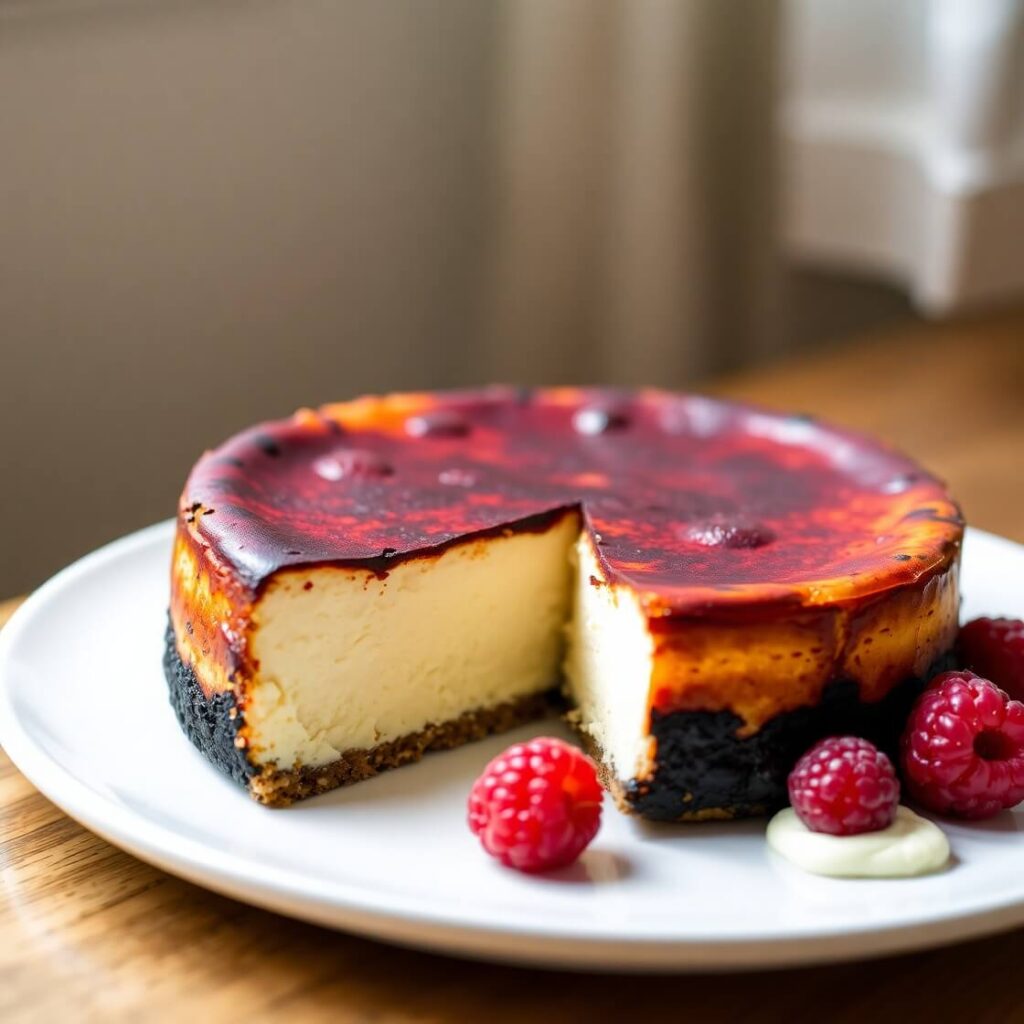
Step-by-step, here’s how to get the perfect Basque Burnt Cheesecake:
Step 1: Preheat your oven to a high temperature — typically 400°F (200°C). The heat is crucial to creating that burnt top.
Step 2: Line a 9-inch springform pan or cake pan with parchment paper. Make sure the paper extends above the rim, as the cheesecake will rise and you want to prevent sticking.
Step 3: Beat the cream cheese in a large mixing bowl until smooth and creamy, with no lumps remaining.
Step 4: Add the granulated sugar gradually, continuing to beat until fully incorporated and silky.
Step 5: Crack the eggs one at a time into the mixture, beating well after each addition to ensure a smooth batter.
Step 6: Pour in the heavy cream and vanilla extract, and mix gently but thoroughly until combined.
Step 7: Sift in the all-purpose flour and a pinch of salt, folding it in carefully to avoid overmixing, which can toughen the cake.
Step 8: Pour the batter into the prepared pan, smoothing the top lightly with a spatula.
Step 9: Bake for about 50 to 55 minutes. The cheesecake should rise and the top will become a dark golden brown, almost burnt-looking but not bitter.
Step 10: Remove from oven and allow to cool completely in the pan at room temperature. The cheesecake will deflate slightly as it cools — this is normal.
Step 11: Once cooled, refrigerate for at least 2 hours to set fully before slicing.
By following these steps carefully, you’ll achieve that signature Basque Burnt Cheesecake texture — crusty on top and silky inside.
Substitutions
If you’re looking to adjust or improve the recipe based on what you have or your preferences, here are some helpful substitutions:
- Cream cheese: You can substitute with mascarpone for a slightly sweeter, creamier result, though the texture will be less firm.
- Heavy cream: For a lighter version, use half-and-half, but expect a slightly less rich cheesecake.
- All-purpose flour: For gluten-free baking, you can try almond flour or a gluten-free flour blend, but the texture may vary slightly.
- Sugar: For a less sweet cheesecake, reduce the sugar slightly or use a natural sweetener like honey or maple syrup, but this may affect the crust color.
- Vanilla extract: You can experiment with other flavorings such as lemon zest or almond extract for a twist.
These swaps can make the cheesecake fit dietary needs or personal tastes while maintaining its overall integrity.
Best Side Dishes for Basque Burnt Cheesecake
To elevate your cheesecake experience, pairing it with complementary sides is a great idea. Here are three suggestions:
- Fresh berries (strawberries, raspberries, or blueberries): Their tartness balances the rich cheesecake.
- A drizzle of caramel or berry coulis: Adds a burst of flavor and a beautiful presentation.
- Lightly whipped cream or crème fraîche: For extra creaminess and a delicate contrast.
These sides not only enhance the taste but also add color and freshness to your dessert plate.
Serving and Presentation Tips
Serving Basque Burnt Cheesecake is all about highlighting its rustic charm and rich texture. Because of its deep caramelized top, the cheesecake naturally draws attention and looks impressive without much fuss. When plating, slice the cheesecake with a warm, sharp knife to get clean cuts and prevent the creamy interior from sticking.
For presentation, consider placing each slice on a simple white plate to let the cheesecake’s golden brown tones stand out. Add a few fresh berries or a small dollop of whipped cream on the side for color contrast and balance. If you want to be extra elegant, lightly dust the plate with powdered sugar or drizzle a thin line of berry coulis beside the slice.
If you’re serving to guests, arrange slices on a wooden serving board lined with parchment paper for a rustic yet inviting look. This dessert pairs beautifully with a cup of strong coffee or a glass of dessert wine, completing the experience.
Tips and Tricks to Make This Recipe Even Better
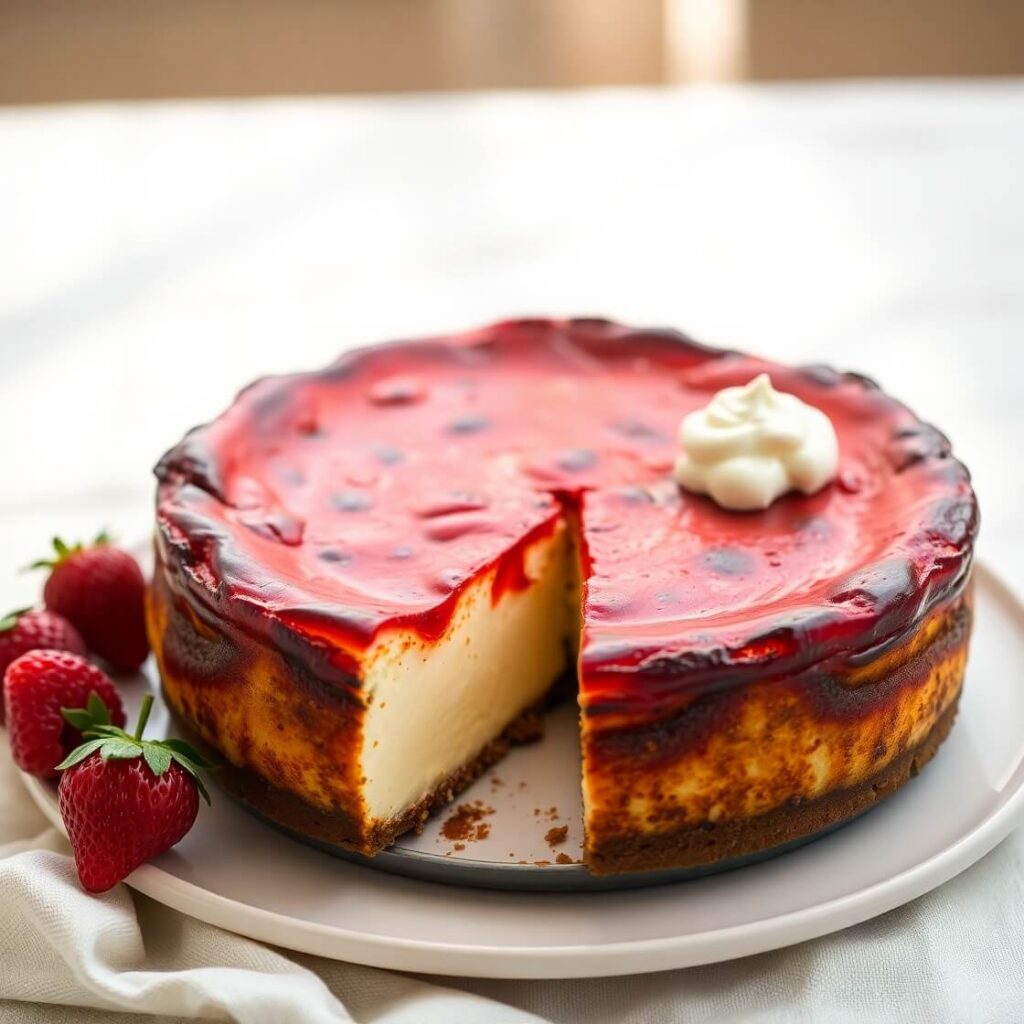
To ensure your Basque Burnt Cheesecake turns out perfectly every time, here are some tips and tricks I’ve learned from experience:
- Use full-fat cream cheese and heavy cream: This combination gives you the creamy texture and rich flavor that makes the cheesecake stand out.
- Bring all dairy ingredients to room temperature: This helps you create a smooth, lump-free batter.
- Don’t overmix once the flour is added: Overmixing can lead to a dense texture rather than the light, custardy inside you want.
- Use parchment paper generously: Lining your pan well prevents sticking and helps with easy removal.
- Bake at a high temperature: The heat is what creates the signature burnt top, so don’t reduce the oven temperature.
- Let the cheesecake cool completely before refrigerating: This helps it set properly and makes slicing easier.
- Use a warm knife to cut: Running your knife under hot water and drying it before slicing ensures neat, clean pieces.
Following these tips will elevate your cheesecake, making it impressive in both flavor and appearance.
Common Mistakes to Avoid
When making Basque Burnt Cheesecake, avoiding these common pitfalls can save you from disappointment:
- Baking at too low a temperature: Without enough heat, you won’t get that characteristic burnt top.
- Not letting ingredients reach room temperature: Cold cream cheese or eggs cause lumps in the batter.
- Overbaking: This will dry out the cheesecake and lose that luscious creamy center.
- Skipping the parchment paper lining: The cheesecake can stick to the pan and become difficult to remove.
- Cutting the cheesecake too soon: If not chilled enough, it will be too soft and messy when sliced.
- Overmixing after adding flour: Leads to a dense, tough texture instead of soft and creamy.
Being mindful of these mistakes will help you achieve the best results.
How to Store It
Basque Burnt Cheesecake stores very well and can be kept for several days if properly handled.
- Refrigerate: Cover the cheesecake tightly with plastic wrap or store in an airtight container. It will keep well for up to 4-5 days.
- Freeze: For longer storage, wrap the cheesecake securely in plastic wrap and aluminum foil and freeze for up to 2 months. Thaw overnight in the refrigerator before serving.
- Avoid storing at room temperature for long periods, as the creamy texture is perishable.
When ready to serve after refrigeration, allow it to come to room temperature for about 15-20 minutes for the best creamy texture.
FAQ
Can I make Basque Burnt Cheesecake without a springform pan?
Yes, you can use a regular cake pan lined well with parchment paper, but a springform pan makes removal easier. Just ensure the lining extends above the rim to accommodate rising batter.
Why is the top burnt but the inside creamy?
The high oven temperature causes the sugars on the surface to caramelize and burn slightly, creating the signature dark top, while the inside remains protected and slowly sets to a creamy custard.
Can I use low-fat cream cheese or milk instead of heavy cream?
It’s not recommended. Using full-fat ingredients ensures the rich texture and flavor. Low-fat substitutes will make the cheesecake less creamy and may affect baking time and texture.
How long should I let the cheesecake cool before refrigerating?
Allow it to cool completely at room temperature, usually around 2 hours. Cooling slowly helps the cheesecake set properly and prevents cracks.
Can I add flavors like lemon or chocolate to this recipe?
Yes! You can add lemon zest or a bit of melted chocolate to the batter for variation, but keep in mind this might slightly change the texture and appearance.
Print
Basque Burnt Cheesecake
- Total Time: 3 hours (including cooling and chilling)
- Yield: 8 1x
- Diet: Vegetarian
Description
A rustic, indulgent cheesecake from Spain with a signature caramelized burnt top and a creamy, custardy center. This simple yet elegant dessert requires minimal ingredients and effort but delivers maximum flavor and wow factor. Perfect for cheesecake lovers looking to try something unique and delightful.
Ingredients
Instructions
- Preheat oven to 400°F (200°C). Line a 9-inch springform pan with parchment paper, extending above the rim.
- Beat cream cheese until smooth. Gradually add sugar and beat until creamy.
- Add eggs one at a time, mixing well after each.
- Mix in heavy cream and vanilla until combined.
- Sift in flour and salt, folding gently to avoid overmixing.
- Pour batter into prepared pan and smooth top.
- Bake for 50–55 minutes until top is deeply golden and slightly burnt, but center jiggles slightly.
- Cool completely at room temperature, then refrigerate at least 2 hours before serving.
Notes
- Use room temperature ingredients to avoid lumps.
- Don’t reduce oven temperature; high heat is key for the burnt top.
- Let cheesecake rest before cutting for best texture.
- Parchment paper should be generous to prevent sticking and help removal.
- Prep Time: 15 minutes
- Cook Time: 50 minutes
- Category: Dessert
- Method: Baking
- Cuisine: Spanish
Nutrition
- Serving Size: 8
- Calories: 520
- Sugar: 28g
- Sodium: 220mg
- Fat: 44g
- Saturated Fat: 27g
- Unsaturated Fat: 12g
- Trans Fat: 0g
- Carbohydrates: 20g
- Fiber: 0g
- Protein: 8g
- Cholesterol: 145mg

